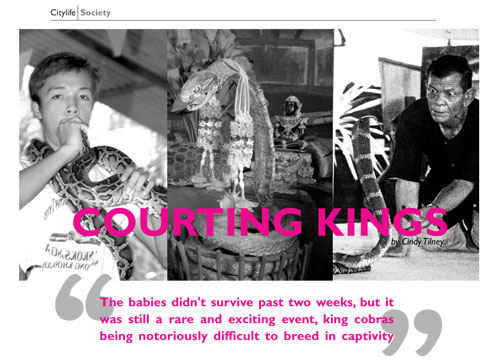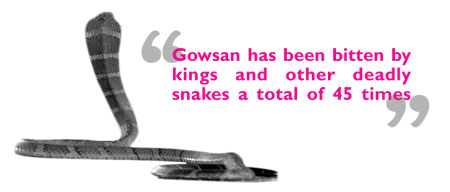
“Kinky!” enthused one of my friends when I told her I’d be sleeping with king cobras. I hadn’t thought of it in quite those terms but I had to admit – the concept of spending the night in Ban Khok Sang Nga did have a freakishly Freudian element to it. I’d stumbled across the name of this remote Isaan village (population 641) on the net: According to a handful of web reviews – mostly regurgitated – almost every resident owns a king cobra as a pet. This formidable serpent – Ophiophagus hannah – is the world’s largest venomous snake, reaching an average size of 3.7 metres, with the largest specimens getting up to 5.5 metres. Once ubiquitous to the hot, watery reaches of South East Asia, India and southern China, kings are vanishing at a rapid rate, threatened by habitat loss and human beings, who kill them out of fear or for commercial gain.
Ban Khok Sang Nga’s curious connection with king cobras first began almost 60 years ago, when a herbalist known as Old Man Ken Yongha began selling his wares in satellite villages, using snake shows to attract crowds and increase sales. The tactic was such a success that it spread throughout the hamlet and today, the villagers still travel from place to place, selling herbs and charming snakes. Their medicinal merchandise, called wan pahyah ngu – loosely translated as ‘big snake plant’ – is said to counteract snake venom and soothe insect bites. Both the herb sales and the reptilian performances provide much needed sideline incomes for the villagers, most of whom are financially strapped farmers.
After a 10-hour journey to Khon Kaen I stumble groggily off an air-conditioned night bus into a sweltering Isaan morning. From here it’s another hour to the entrance of a dusty road, marked by a lone som tam stall and a sign reading King Cobra Conservation Project. A motorbike taxi takes me the remaining two kilometres to the heart of Ban Khok Sang Nga, and delivers me to the president of the King Cobra Club of Thailand, Ta Butta, who has arranged a homestay for me with his older brother – a wiry and taciturn man in his sixties with a shock of white hair, who in rare moments breaks into a wide grin to reveal a number of missing teeth – and his congenial, rotund wife who insists I call her Yai.
Ta explains that the King Cobra Club of Thailand was founded by the residents of Ban Khok Sang Nga almost 60 years ago, to promote conservation of this endangered species. In 1996 the members set up a king cobra breeding programme in cooperation with the Veterinary Faculty of Khon Kaen University and a year later, 13 hatchlings were born at the village temple. The babies didn’t survive past two weeks, but it was still a rare and exciting event, king cobras being notoriously difficult to breed in captivity.
The university professors now work in a more controlled experimental environment on the Khon Kaen campus, but the villagers still mate their snakes and deliver any eggs to the sanctuary of the faculty’s incubators.
Intrigued by the villagers’ propensity to handle such lethal snakes on a regular basis, I ask Ta about fatalities over the years. “Only two people have died from snake poison since Old Man Ken Yongha first began giving his shows in 1951,” he says. “Many more have been bitten, but most victims have survived.” This is surprising, given that in the old days, the closest source of anti-venom was Khon Kaen Hospital – a 45-kilometre, one-hour drive away. The serum is now stocked by the district hospital, which can be reached in just 20 minutes, but many villagers still attribute the high survival rate to the powers of wan pahyah ngu and the local mor ngu, a ‘snake doctor’ who performs a sacred ritual whenever someone is bitten.
After a breakfast of dried squid strips, red ants’ eggs, sticky rice and – blessedly – an omelette, I head to the town square, where snake performances are held for visiting tourists. The stage, beneath a corrugated iron roof, is covered in green felt and watched over by a massive cardboard cobra. To one side is a bizarre shrine, cluttered with Buddha images, snake statues and dried Ophiophagus hannah specimens. Behind it, wire enclosures contain a motley menagerie of deadly serpents, peacocks, bad-tempered monkeys in painfully small quarters, two alligators soaking in a few murky inches of water, and a long-haired white rabbit sandwiched between two king cobras. Fortunately for Fluffy, kings feed almost exclusively on other snakes, with the odd frog or lizard thrown in, but I couldn’t imagine the proximity of several pythons and an anaconda making for a happy bunny.
A man armed with a Polaroid camera wanders over to me, introducing himself as Gowsan and wasting no time in negotiating a snapshot of me with his pet python draped around my neck. The snake is heavy and I can feel the solid muscle and intricate bone structure beneath the skin, which is cool and smooth, like a length of silky fabric draped around a heavy, intricately linked chain. Retrieving her from where she’s twined herself around my handbag straps, Gowsan promptly pops her head into his mouth, then down his pants, at which point I feel a serious pang of sympathy for the python.
One of the village’s senior charmers, Gowsan is 73 but looks much younger – only the milky rings around his irises reveal his true age. But when the show starts he demonstrates the masterful skills he’s honed over the years. Fixing a maniacal gaze on his king cobra, he cajoles, taunts and teases the snake, then dodges its lightning quick strikes with incredibly rapid reflexes.
After similar performances by several other charmers, including two pre-teen boys braving slightly less lethal serpents, I resume my chat with Gowsan.
He’s been playing with snakes since his early 20s, he tells me, and performing with them for over 30 years. He currently keeps eight at his house – seven kings and his python – and has a special affection for each one of them. He rattles off their names: Jao Lad, Majurat, Payalae, Tam Than, Num Nim, Tum Tam, the python Nam Chok, and a brand new one he hasn’t yet named. He keeps them separately, “according to their kind,” in large wooden boxes and feeds them every two to three days. Nam Chok has a penchant for poultry, while the kings prefer other snakes, geckos and frogs.

I notice that the index and baby fingers of Gowsan’s right hand are missing down to the knuckle – necrotic casualties of the king’s cell-rotting poison. “This one was from a cobra bite”, he says matter-of-factly, brandishing one stump, “and this one from a king cobra.” He leads me to a board bearing photos of him and other charmers in action. Pointing to one of him with a king cobra’s head firmly clasped in his mouth he tells me, “I don’t do that anymore, after being bitten three times on the lip.”
In fact, Gowsan has been bitten by kings and other deadly snakes a total of 45 times and, amazingly, is still around to tell the tale(s). The king cobra’s potent poison is composed mainly of neurotoxins that attack the nerve tissues and central nervous systems, backed up by cardiotoxins that damage the heart. The venom of an adult snake is sufficient to kill up to 108 people, but is never injected all at once. Still, a single king cobra bite can bring down an Asian elephant, and take out a grown man in record time: “About half an hour if you aren’t strong,” nods Gowsan sagely. But, he adds with a hint of pride, after countless close shaves with death he’s developed a degree of immunity to snake poison. The last few times he’s been bitten the doctors haven’t even bothered to administer anti-venom – he’s just consulted the mor ngu, eaten some wan pahyah ngu and waited for the storm to pass.
As we’re talking, another charmer, Tom, rocks up on his innovative version of motorised transport – a homemade contraption crafted from an antiquated Honda welded to a brightly painted trailer, where once again a wooden snake box rests. It contains his personal serpent – a male king of about 20 years old, with the rather grandiose name of Singh Klang Singh Dong Moon. He opens the box to reveal an olive-coloured king coiled in multiple loops, hood flickering like a hologram as he tastes the fresh air. Does he love his snake? I ask Tom. Yes, he replies earnestly, he loves him very much.
That evening, a neighbour wanders over to inspect the lone female farang next door, introducing herself as Samong. Does she keep a king cobra as a pet, I ask? Yes, she nods, there are two at her house, but she doesn’t play with them – her son-in-law does. She’s scared of being bitten – like he was just a month ago on his finger, which has still not properly healed. While we’re chatting, an ear-splitting belch rips though the darkness from across the street, making me start slightly, but Samong simply gives me a tranquil smile.
When I wake up the next morning at 7.30, it’s already insanely hot. Hoping for a breath of a breeze, I walk out to the front porch, just in time to see Gowsan trundling past on his ancient rattle trap of a Honda Dream, trademark wooden snake box strapped in place behind him with bungy cords. I shudder to think of the consequences of even the most minor motorcycle accident in these parts. It’s the new snake, he tells me later when I see him at the stage, a king he’s just bought for 5000 baht. He’ll be charming her for the first time today. Grinning widely, he seems to relish the prospect. I stick around long enough to see Gowsan come through his novel encounter with flying colours, then set off for the long haul back to Chiang Mai.
How to get to Ban Khok Sang Nga:
Take a bus from Chiang Mai’s Arcade Station to Khon Kaen (roughly 11 hours). A green ‘Kranuan’ bus goes every hour from the bus station and drops you off at the entrance to the village for 30 baht, from where it’s a 2 km walk or motorbike taxi ride.
For more information, contact Ta Butta, President of the King Cobra Club on 081-974 9499 or 043 924 070. For 300 baht he can set up a one-night home stay, including dinner and breakfast. Alternatively, you can stay in Khon Kaen or Nam Pong.
Show time: 9 a.m. – 5 p.m. daily
